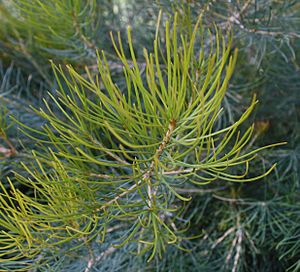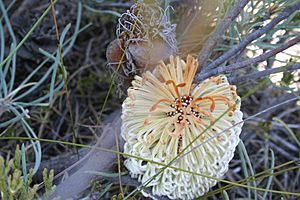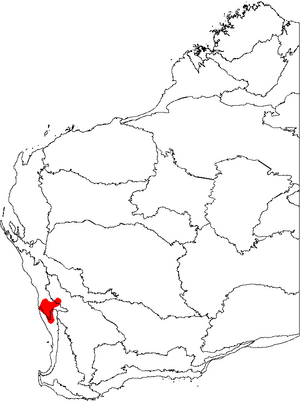Banksia grossa facts for kids
Quick facts for kids Banksia grossa |
|
|---|---|
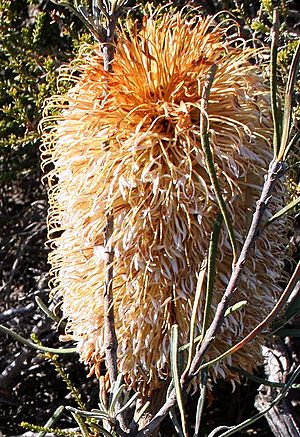 |
|
| B. grossa north of Badgingarra | |
| Scientific classification | |
| Genus: |
Banksia
|
| Species: |
grossa
|
Banksia grossa is a special type of shrub found only in Southwest Australia. It belongs to the Proteaceae plant family. This plant is one of 14 kinds of banksia in a group called Abietinae. All these plants have flower spikes that are mostly shaped like cylinders or ovals.
A botanist named Fred W. Humphreys first collected a sample of Banksia grossa in 1965. Later, in 1981, another botanist, Alex George, officially described it. Its thick leaves and large seeds make it stand out from other plants in its group. This is also why it got its name, grossa, which means "coarse" in Latin.
You can find Banksia grossa growing in sand or sandy soil over laterite rock. It lives among heath plants between Eneabba and Badgingarra in Western Australia. This shrub can grow up to about 1 metre (3 feet) tall. It has many stems, narrow leaves, and oval-shaped brownish flower spikes. These spikes can be up to 10 centimetres (4 inches) tall and are made of hundreds of tiny flowers.
Banksia grossa flowers during the cooler months, from March to September. After flowering, the spikes grow woody seed pods called follicles. These pods hold the seeds. When there's a bushfire, Banksia grossa can grow back from a special woody base called a lignotuber. Bushfires also help the seeds to be released from their pods, and new plants can grow after the fire. Insects and a small nocturnal mammal called the white-tailed dunnart visit the flowers, likely helping to pollinate them.
Contents
What Does Banksia grossa Look Like?
Banksia grossa is a bushy shrub. It usually grows about 70 centimetres to 1 metre (2.3 to 3.3 feet) tall. Sometimes, it can reach up to 1.5 metres (5 feet). It has many stems that grow from a woody base. Young stems have soft, woolly hairs, while older stems have flaky, pale brown bark.
Leaves and New Growth
The leaves are a bit thick and feel like needles. They are 4 to 12 centimetres (1.6 to 4.7 inches) long and only 2 to 3 millimetres (0.08 to 0.12 inches) wide. They are thicker than the leaves of other plants in the Abietinae group. The edges of the leaves are straight and roll inwards. When they are young, the top of the leaves has a few hairs, but they become smooth later. New leaves grow in spring and early summer.
Flowers and Spikes
The flowers of Banksia grossa grow in a typical Banksia flower spike. This spike is an inflorescence made of hundreds of small, individual flowers. These tiny flowers are packed very closely around a woody centre, completely covering it. The woody centre is 5 to 7 centimetres (2 to 2.8 inches) tall. The flowers spread out from this centre, making the whole spike 8 or 9 centimetres (3.1 to 3.5 inches) wide.
The flowers are rusty brown to golden brown. Each flower has a hairy tube, which is 3.4 to 4.5 centimetres (1.3 to 1.8 inches) long. When the flower opens, a dark red to purple style (a part of the flower) comes out. This style is 3.8 to 4.8 centimetres (1.5 to 1.9 inches) long and curves at the tip. The flower spikes grow from short, thick branches. Some spikes also grow at the very ends of branches, making them easy to see.
Flowering Time and Nectar
Banksia grossa usually flowers between March and September. However, sometimes it can start flowering as early as December. It takes about five to eight weeks for a flower to fully develop and finish flowering. About three weeks before the flowers open, they give off a strong, musky smell. The flowers open one by one, starting from the bottom of the spike and moving up to the top over about two weeks.
When the flowers open, they produce a lot of nectar. Sometimes, there's so much nectar that it drips onto the ground! After the flowers finish, they dry up and curl against the spike, making it look hairy. This is now called an infructescence, which is like a fruit-bearing spike. It is about 6 to 10 centimetres (2.4 to 3.9 inches) tall and 4 to 8 centimetres (1.6 to 3.1 inches) wide.
Seed Pods and Seeds
Up to 25 smooth, oval-shaped seed pods (follicles) grow on the spike. Each pod can hold up to two large, wedge-shaped seeds with wings. These pods are 2 to 4.5 centimetres (0.8 to 1.8 inches) long. At first, they are covered in fine fur, but this rubs off as they get older. The pods usually stay closed until a fire opens them.
The seeds of Banksia grossa are the biggest among all the species in the Abietinae group. They are 2.8 to 3.9 centimetres (1.1 to 1.5 inches) long. The main part of the seed is wedge-shaped, and it has a wide wing. When a seed sprouts, it first grows two bright green leaves called cotyledons. These come from a reddish, hairy stem. The first true leaves are long and narrow, also covered in white hair.
How Banksia grossa Was Named
The first time Banksia grossa was officially described was in 1981 by botanist Alex George. He based his description on a sample he collected in 1969. He noticed that its leaves, flowers, and fruits were "coarse" (meaning rough or thick) compared to other plants in its group. This is why he chose the name grossa, which comes from the Latin word for coarse.
Scientists group plants into different categories to understand how they are related. Alex George placed Banksia grossa in a specific group because of its flower spike and the shape of its styles (a part of the flower). Later, other scientists used DNA information to study the relationships between Banksia species. These studies showed that Banksia grossa is closely related to other species like Banksia telmatiaea and Banksia leptophylla.
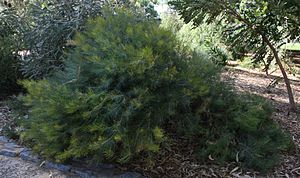
Where Banksia grossa Lives
Banksia grossa mostly grows in Western Australia. You can find it from west of Yandanooka in the north, down to Badgingarra National Park in the south, and almost to Coorow in the east. It prefers shallow sand over laterite rock, or deep sand. Sometimes, it grows on top of laterite hills. It lives in flat or gently rolling areas among kwongan shrubland (a type of bushland). About 40% of these plants grow along roadsides.
How Banksia grossa Survives and Thrives
Banksia grossa is very good at surviving bushfires. After a fire, it can grow new shoots from its woody base, called a lignotuber. This means it doesn't rely only on seeds to come back. These shrubs don't carry as many seeds as some other plants that only grow back from seeds after a fire. However, the seeds that stay on the plant are less likely to be eaten by animals.
The seed pods usually open after a bushfire, releasing the seeds. These seeds then sprout after the ground has been disturbed. Plants that resprout, like Banksia grossa, do better when there are longer times between fires. This gives them more time to build up their seed supply. Studies show that the pods need high temperatures to open after burning. For example, 50% of pods opened after being exposed to 270°C (518°F), and 90% opened after 400°C (752°F).
Special Leaves for Dry Climates
The leaves of Banksia grossa are specially designed for dry weather. The lower surfaces of the leaves are protected because their edges curl inwards, almost touching the middle vein. Tiny hairs (trichomes) also grow along the middle vein and edges. This protects the tiny pores (stomata) on the leaf surface, which helps the plant save water. Scientists believe that this plant and its relatives developed these long, narrow, inrolled leaves as they moved into drier areas of Australia's southwest.
Visitors to the Flowers
The flower spikes of Banksia grossa attract many insects. A rare bee species called Hylaeus globuliferus has been seen visiting them. Many ladybirds have also been reported drinking the nectar from these flowers, even when other Banksia flowers were nearby. The white-tailed dunnart, a small marsupial, has also been seen visiting the flower spikes. Pollen has been found on the noses and in the droppings of several types of dasyurid marsupials. This suggests that these animals likely help pollinate Banksia species in general.
Unusual Nectar
Banksia grossa is one of five closely related Banksia species that have very unusual flower nectar. Most Banksia plants have clear, watery nectar. But the nectar of Banksia grossa starts as pale yellow and then gets darker and thicker. Within a day or two, it turns into a thick, olive-green slime. Eventually, it becomes an almost black, jelly-like lump stuck to the base of the flowers.
Scientists first noticed this in 1980. At first, they thought tiny bacteria might be causing the colour change. However, later research suggested that the colour change is a natural chemical process from the plant itself. The purpose of this coloured nectar is not fully clear, especially since animals that visit at night don't usually rely on sight to find food. But it's possible that nectar that changes colour or smell as it gets older might encourage pollinators to visit it more often than newer nectar.
Growing Banksia grossa in Gardens
People grow Banksia grossa in gardens because of its attractive needle-like leaves and rusty-brown flower spikes. The colours of both can vary quite a bit. This plant likes sandy or loamy soils that drain well and are a bit acidic (with a pH between 5.5 and 7). It also needs a sunny spot. Once it's settled, it can handle dry periods. You can prune it quite a lot because it will grow back from its woody base.
You can grow Banksia grossa from seeds. The seeds don't need any special treatment before you plant them, and they usually sprout in about 14 days. This plant grows slowly. It takes about 5 to 7 years for it to become mature and start flowering.
See also
 In Spanish: Banksia grossa para niños
In Spanish: Banksia grossa para niños


